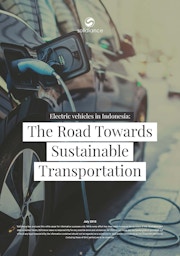
In the past few years, Indonesia has heavily relied on fossil fuel as the main energy source in all economic sectors, ranging from transportation, power plant, to household.
The high dependency on fossil fuel has resulted in several negative impacts such as:
- Increasing state budget allocation towards fuel subsidy. As petrol is the main energy source for transportation in Indonesia, people have no alternative choice for cheaper source of energy. To provide affordable energy source, the government enacted a policy to subsidize 10 per cent of state budget towards fuel.
- Energy sustainability issues. Without the current consumption rate and extraction technology, Indonesia’s crude oil reserve is expected to last for only 12 years. This has raised issues related to future sustainability of the nation’s energy source.
- CO2 emission rate. Given the high use of fossil fuel, CO2 emission rate in Indonesia is one of the highest emitters in the world. Meanwhile, transportation has been identified as a sector of high energy consumption. In 2016, ~25 per cent of total energy consumption came from the transportation sector with CO2 levels reaching 31.5 per cent of total emissions.
Considering all factors mentioned, shifting to a renewable energy source in the transportation sector could mitigate high levels of CO2. The introduction of electric vehicles, given its benefits of emitting less pollution and its minimum reliance on fossil-based energy source, would then be seen as the most probable and realistic solution.
But while the benefits of energy efficient electric vehicles (EV) outweigh the cheaper costs of gasoline-based vehicles, EV in Indonesia has yet to gain its expected and maximum traction. In response to the slow adoption rate, the government has set a national roadmap in the development of the automotive industry and plans to target EV penetration as much as 2.1 million units for 2-wheeler vehicles (2W) and 2,200 units for 4-wheeler vehicles (4W) by 2025. However, with current rate of adoption and unsolved issues in the market, it is unlikely that the target would be achievable.
In this white paper, Solidiance identifies several key areas that could provide business opportunities in supporting the growth of EV penetration. Our research revealed that clear government regulations and a supporting infrastructure (fast charging stations, swapping stations, and recharging stations) are seen as areas of opportunity that is worth exploring in the EV market for all interested players to play/enter in.
Publish your content with EB Publishing
It's about who you reach. Get your news, events, jobs and thought leadership seen by those who matter to you.










